Latest reviews
The main focus of Hardcore Gaming 101’s “Retro Indie Games” book series are games that look, feel and/or play like old-school games from the 1980s and 1990s, but that are much more recent indie titles. (See my review of the first volume.)
The second volume covers both old titles that didn’t make the cut last time (e.g., Papers, Please! and Fez), and very recent games like Helltaker, Paradise Killer and Lair of the Clockwork God.
The format is largely the same as before: each game is richly illustrated and described in detail, with heavy focus on gameplay and story, and little emphasis on any other aspect such as the developers or how the game was made. As before, games are grouped by developer.
With 67 individual games, every reader with any appreciation for indie games is likely to discover at least one or two to add to their backlog. For me, that included Katana Zero (the time manipulation mechanic sounds super-interesting) and The Binding of Isaac (it just seems like a wild ride).
As with the first volume, I still feel the series could do better at being an actual guide to genres and developers. As an effort to catalog and describe some of the greatest retro-styled indie titles of the last decade or so, it is without equal.
The full list of games in the second volume follows (grouped by developer):
Cuphead
Celeste
Panzer Paladin
The Messenger
Cyber Shadow
Gunpoint
Aces Wild
Blazing Chrome
Katana Zero
Minit
Fight ‘n Rage
198X
Cave Story
Kero Blaster
La-Mulana (series)
Xeodrifter
Hollow Knight
Blasphemous
Iconoclasts
Dex
Rabi-Ribi
Pharaoh Rebirth
Touhou Luna Nights
Record of Lodoss War: Deedlit in Wonder Labyrinth
Fez
The Binding of Isaac
Dusk
Project Warlock
AMID EVIL
Cruelty Squad
Saturday Morning RPG
Cosmic Star Heroine
Anodyne
Anodyne 2: Return to Dust
Into the Breach
Chroma Squad
Katawa Shoujo
Digital: A Love Story
Don’t take it personally babe, it’s just not your story
Analogue: A Hate Story/Hate Plus
Ladykiller in a Bind
Broken Reality
Coffee Talk
Unavowed
Lamplight City
The Low Road
Ben There, Dan That!
Time Gentlemen, Please!
Lair of the Clockwork God
Paradise Killer
Return of the Obra Dinn
Umurangi Generation
Hypnospace Outlaw
Oxenfree
Back in 1995
Stories Untold
The Count Lucanor
Yuppie Psycho
Detention
Devotion
Paratopic
Anatomy
Papers, Please
Stardew Valley
Helltaker
As a twelve-year-old, Gwendy Peterson met a stranger who gave her a magical box that can destroy the world. That’s the premise of the Gwendy trilogy by Stephen King and Richard Chizmar.
The first book, Gwendy’s Button Box (review), was a fine story that stood on its own as a morality tale. The titular button box can fulfill wishes and wreak destruction—including at the planetary scale. As child custodian of the box, Gwendy used some of its powers, but was never corrupted by them.
In the mediocre sequel, Gwendy’s Magic Feather (review), Gwendy became a celebrated author and elected Congresswoman, and the box once more played an (ultimately anticlimactic) role in her life.
In Gwendy’s Final Task, the mysterious man or being who originally gave her the box tasks her to get rid of it once and for all. Because it’s a magical box, throwing it into a volcano won’t do. It must be…shot into space!
And so it is that Gwendy, now a Senator, finds herself on the way to a space station, with the button box locked away in a steel box marked “CLASSIFIED MATERIAL”. The spaceflight is organized by a SpaceX-style private company that is hoping to monetize space tourism.
That explains why one of the other passengers on board is an obnoxious billionaire. It doesn’t explain why the man seems to be completely obsessed by what’s in the steel box. Meanwhile, Gwendy is literally losing her mind to early onset Alzheimer’s disease.
The setup is ridiculous, but it mostly works. The enclosed environment, combined with Gwendy’s dwindling mental faculties, builds suspense. King rewards his constant readers with plenty of references to other works, including the Dark Tower series many consider his magnum opus.
The ending leaves no doubt that this truly is the final book in the series. That’s probably for the best. If you’ve made it to the second book, the conclusion is definitely an improvement, and I would recommend picking it up. If you’ve not started the trilogy yet, there are much better works in King’s oeuvre.
In the late 19th century, as the United States fully consolidated itself and its territory (through war and ethnic cleansing), its elites began to realize openly imperial ambitions. These ambitions reached a fever pitch in the Spanish-American War, which led to the US establishing control over Puerto Rico, the Philippines, Guam, and (nominally independent) Cuba.
When Smedley Butler, the son of an influential Pennsylvania family, joined the US Marines in 1898, he was caught up in the war fever of the time. But instead of fighting the Spanish, he soon found himself helping to police America’s empire on behalf of its most powerful economic interests.
Decades later, Butler, now a Major General, started to write his own script. In 1933, he alleged that he was invited to take part in a conspiracy among wealthy businessmen to overthrow U.S. President Roosevelt and install a dictator.
It became known as the Business Plot. A congressional committee concluded that “there is no question that these attempts were discussed, were planned, and might have been placed in execution when and if the financial backers deemed it expedient." Nobody was prosecuted.
In his final years, an increasingly radical Butler gave fiery speeches and penned a short book called War is a Racket. It contains the following passage:
I helped make Mexico, especially Tampico, safe for American oil interests in 1914. I helped make Haiti and Cuba a decent place for the National City Bank boys to collect revenues in. I helped in the raping of half a dozen Central American republics for the benefits of Wall Street.

Late in his life, Butler denounced war and empire, and fought for veterans’ rights. (Credit: Bettman/Getty Images. Fair use.)
Legacies of Empire
For American journalist Jonathan Katz, Butler’s life presents a lens through which to view the history of American imperialism, and its modern legacies. In Gangster of Capitalism, Katz traces Butler’s career in the military and his stint as Philadelphia’s “Director of Public Safety”, a role in which he waged a brutal war on crime in the city.
Katz makes it clear that Butler, in spite of his Quaker upbringing, committed truly horrific and violent actions, and often rationalized them through the pervasive racism of the time. As part of the nearly 20-year-long occupation of Haiti by the United States, Butler instituted de facto slavery to build up the country’s infrastructure.
Unlike the opaque Business Plot, the corporate interests that profited from these endeavors and drove US policies are well-documented, from bankers to landowners to oil companies. Franklin Roosevelt himself pursued personal agriculture investments in Haiti while helping direct its occupation as Assistant Secretary of the Navy.
In each chapter, Katz describes the modern legacy of American imperialism, including by quoting Haitians, Filipinos, Chinese, and others he has met. While Americans have forgotten the little they have ever known of this history, the citizens of these countries have not. Katz’s travelogue enriches the book and makes this history tangible.
Past and Prologue
Gangsters of Capitalism is an accessible, informative and engaging book. At no point does Katz turn from facts to polemic. He gives clear-eyed accounts of the brutal regime of Nicaragua’s leftist autocrat Daniel Ortega, and the imperialist ideology of China under Xi Jinping. The book is a critique of empire, not an anti-American screed.
It is also a timely book, as another imperialist power, Russia, wages a war of aggression against neighboring Ukraine. What role should Western powers play today to counter such naked brutality? Can military alliances like NATO protect the peace in the 21st century? What alternatives are there?
The invasion of Ukraine marks a new chapter in world history, and we all benefit from remembering previous chapters—including America’s own brutal imperial history—to navigate the moral landscape now before us.
Dexter war vor Jahren eine meiner Lieblingsserien und das ging bestimmt nicht nur mir so. Innerhalb der ersten vier Staffeln wurde die Handlung um den Serienmörder in Diensten der Polizei spannend und gut inszeniert herübergebracht. Die weiteren vier Staffeln kamen nicht mehr an das Niveau der anderen heran aber trotzdem bleib ich dabei um zu erfahren wie es weitergeht. Und am Ende der achten Staffel war für mich klar, das es nicht mehr weitergehen kann. Der Abgang Dexters hat für mein Empfinden keinen Spielraum für eine Rückkehr gegeben. Tja, was soll ich sagen? Ich habe mich getäuscht.
Die Geschichte startet in einer US-amerikanischen Kleinstadt und ich war von Anfang an wieder im Dexter-Fieber. Vergessen war das seltsame Ende der achten Staffel. Die Stimmung im winterlichen Handlungsort ist gut eingefangen und wird rund um den Hauptdarsteller gut aufgebaut. Auch wenn in der ersten Folge für Neulinge nicht ganz klar wird, was hier eigentlich los ist. Diese Folge wird meiner Meinung nach nur zur Schaffung der Atmosphäre verwendet. So kommen auch Leute, die bisher keinen Kontakt mit Dexter Morgan hatten, in die Dexter-Stimmung.
Anfangs ist unklar wer welche Rolle hat. Wer ist der Böse, wer nicht und wann kommt es zur ersten Dexter-typischen Handlung. Der Reiz und die gut eingefangene Atmosphäre haben mich die komplette Staffel in drei Tagen durchschauen lassen und es war zu keinem Zeitpunkt langweilig. Die Spannung wird gut aufgebaut und es wird langsam aber sicher klar wer welche Rolle spielt und welches Schicksal diese Personen erleiden werden.
Warnung: Der untenstehende Text enthält Spoiler.
Diesmal wird es leider endgültig keine Fortsetzung geben. Aus dem für mich nicht hervorsehbaren Ende kommt selbst Dexter nicht mehr heraus. Aber wer weiß ob sein Sprössling nicht den selben Weg einschlägt und wir in ein paar Jahren eine weitere Staffel zu sehen bekommen. Wir werden es sehen.
Vampire Survivors by indie developer Luca “poncle” Galante was released in December 2021. It only costs $3 and is still in early access, but has already racked up tens of thousands of “overwhelmingly positive” reviews on Steam.
The game’s formula is simple but brilliantly executed, once you look past its rudimentary 16-bit style pixel graphics. Your goal is to survive for 30 minutes against ever-growing mobs of monsters. You start with a single weapon, but as you defeat monsters, you level up quickly. So far, that sounds like many twin-stick shooters.
The game-changing part of the Vampire Survivors formula is this: There’s no need for button-mashing, as your character auto-fires all weapons at their maximum firing rate.
As someone who quickly gets controller fatigue from many action games, I found it surprisingly chill to play, in spite of the amount of stuff happening on the screen. You avoid enemies, destroy them with an ever-growing arsenal of weapons, collect experience gems, and level up.
Power-ups from hell
Level up enough, and the game’s promise that “you are the bullet hell” becomes fulfilled. It’s hard to convey just how insane things can get. Consider that this shows only a mid-level build:
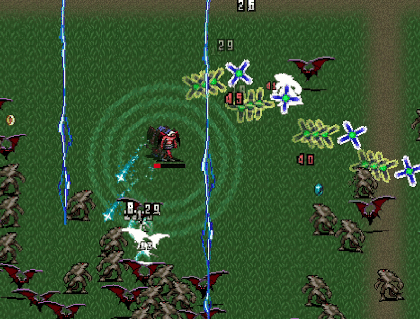
Character “Krochi” facing an onslaught of monsters in the first stage. (Credit: Luca Galante. Fair use.)
To make it through 30 minutes, you need to continually improve your build, and combine items into ultra-powerful “evolved” weapons. You can also use collected coins from a run to buy persistent power-ups that will help you with all future runs.
It won’t take you more than a few hours to master the first stage, but Vampire Survivors has lots more to offer. You can unlock many different characters (who may have their own unique weapons), additional stages, and additional difficulty levels.
While the maps are generally super-simple, there are a few surprises. For example, the “Dairy Plant” map features new mechanics, such as little carts you can push in the direction of oncoming enemies, and special floor tiles that trigger enemy waves to spawn.
Challenging but not limitless
Even though it is still in early access, Vampire Survivors easily offers 10-20 hours of frantic play as of this writing; content updates have been forthcoming at a rapid clip. If you like action games and don’t find the visual intensity offputting (or worse), you’ll definitely want to check it out.
Unlike roguelikes that offer nearly endless challenges, most players will eventually hit a ceiling as they accumulate persistent power-ups and develop ever-more successful builds. But for $3, that’s still a hell of a lot of entertainment (no pun intended), and anyone trying the game now should revisit it again in a few months as it continues to be expanded and balanced.
I played Vampire Survivors on Linux using Proton without issues (I did have to set the launch options to PROTON_LOG=1 %command% as recommended on ProtonDB).
Additional reading
-
In February, NME published a nice interview with developer Luca Galante.
-
As usual, a Fandom wiki has quickly popped up; if you don’t want to discover every combo for yourself, the weapons evolution guide in particular is indispensable.
What if you took some of the best ideas from the roguelike deck-building genre, but instead of being dealt cards, you rolled dice on each turn? That’s the premise of a ridiculous, addictive, and sometimes frustrating game called Dicey Dungeons.
Developer Terry Cavanagh has published indie games since at least 2008, but his breakthrough titles were the puzzle platformer VVVVVV (2010) and the brilliant twitch game Super Hexagon (2012).
When I first looked at Dicey Dungeons, I was not especially enamored. Anthropomorphized dice, really? The moment you start actually playing it, the game’s self-aware sense of humor makes it all work.
You play as the contestant in a gameshow whose host, Lady Luck, promises to fulfill your innermost desires if you win. The catch? You’re transformed into a dice and are doomed to compete in Lady Lucks’s dungeons forever, with the game clearly rigged against you.
Revenge of the bloodsucking vacuum cleaners
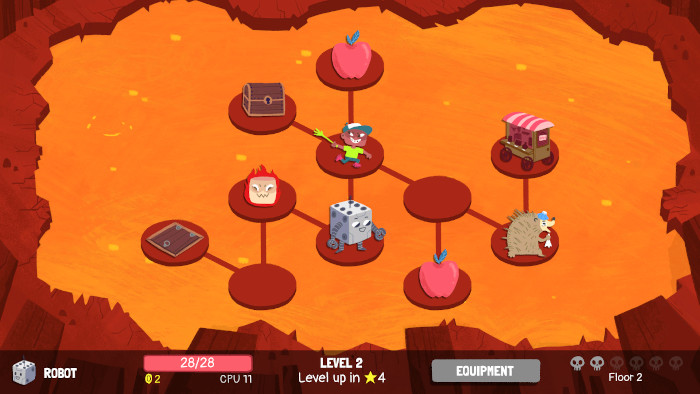
The maps are the least interesting part of the game, but they do show you all the enemies you can fight in a given level. In this case, you can go up against a marshmallow, a coin-stealing kid, and a sickly hedgehog. (Credit: Terry Cavanagh. Fair use.)
The enemies you encounter are not the standard fantasy fare. Instead, your next opponent could be a bloodsucking vacuum cleaner, a snowball-throwing yeti, a poisonous ice cream cone, or a guy whose entire head is a home stereo system.
Battles are turn-based. On each turn, you roll a number of dice, which you then drag and drop to a compatible item in your inventory. You may not have one! For example, all your items might require even numbers, and you might roll a bunch of threes.
It’s a simple enough concept, but with a large variety of enemies and items, it adds up to a rich gameplay experience. By itself, that could make for a 5-10 hour game. What makes Dicey Dungeons a 30-60 hour game is its willingness to throw its own rules by the wayside.
Rules, schmules
As you play the game, you unlock new characters with their own sets of items, and with completely different play styles. For example:
-
a character that casts spells from a spellbook with a fixed number of slots, of which up to four can be active at any given time.
-
a character that, instead of rolling dice, generates random numbers towards a fixed target value. If you hit that target value exactly, you get a jackpot reward.
-
a character that is dealt a set of cards in random order, combining true deckbuilding mechanics with dice.
Moreover, each character advances through six episodes that play with rules in interesting ways. The most interesting of these are the “parallel universe” episodes (in which items and status effects work completely differently) and the bonus episodes (in which you gradually accumulate randomized rules like “after 4 turns, all enemies transform into bears”).
It all culminates in a final confrontation which, again, does something completely new and interesting with the game mechanics. I won’t spoil it for you; suffice it to say that there’s a lot to keep the player engaged. And when you’re done with that, there are some (fairly easy) Halloween bonus episodes as well.
As with Super Hexagon, Cavanagh again collaborated with Chipzel on the music. Unlike the high octane chiptune sound of Super Hexagon, Dicey Dungeons’ soundtrack blends in jazzy flavors, which give the game a unique feel.
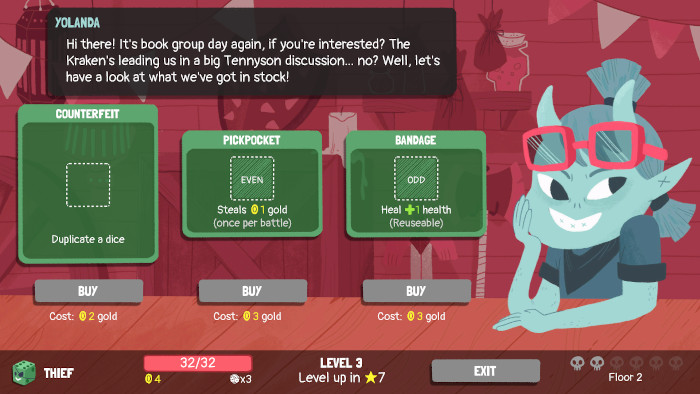
The game’s wit and humor come through in many places, such as when visiting shops. Sometimes the shopkeepers will even remark on specific enemies in the level you’re in. (Credit: Terry Cavanagh. Fair use.)
Dice with rough edges
The game is not perfect. My criticisms of it can be summed up in three categories:
-
Pointless maps: The game features suitably atmospheric levels such as “the libary” or “the dark forest”. But the actual dungeon maps are extremely linear and basic. The most complex choices you’ll make navigating the dungeon are branching questions: This enemy first, or that one?
-
Luck over strategy: Being at its heart a dice game, Dicey Dungeons can be incredibly unfair. An enemy can roll two sixes twice in a row, hitting you with maximum damage and status effects, while you are barely able to make a dent due to a poor roll.
In theory, you can sometimes flee a battle. But that action is almost useless. You’ll still have all your damage, and in many cases you won’t progress unless you defeat the enemy. So, go against the same enemy again with three hit points left, while they’re back at full strength? Good luck! -
Inconsistent execution quality. The spellbook user experience, for example, is very clunky—the drag and drop mechanics are poorly explained and not intuitive. Even though the mechanic had promise, I had the least fun playing that character, just due to the interface feeling so unpolished.
Each character’s list of episodes includes an “elimination round” which, as the name suggests, exists to prevent straightforward progression. It achieves this by making the enemies’ items a lot more powerful. Unfortunately, this can lead to a high number of unwinnable encounters.
The Verdict
Those criticisms shouldn’t distract from the fact that Dicey Dungeons, overall, is a hell of a lot of fun to play. There’s a lot of love in the details, from the silly unlockable enemy biographies, to the clever dialogue during encounters or shopkeeper visits.
I would give the game 4.5 stars, rounded up because of the sheer amount of gameplay variety and content. If you enjoy the deckbuilding formula, and are looking for something similar that may keep you entertained for a few weekends, go and roll those dice—you might get lucky!
The explosion of indie gaming in the 2010s has blessed players with the triumphant return of genres largely written off by major publishers, from 16-bit-style “metroidvanias” to point-and-click adventures. The flip side of this blessing is the problem of discovering the indie gems you truly want to play. That’s where Hardcore Gaming 101’s Guide to Retro Indie Games comes in.
On 152 richly illustrated pages, the first volume presents detailed overviews of many games which, while mostly released in the 2010s, seemed “retro-styled” to the editors. It is, as they acknowledge, a squishy definition:
It’s primarily to refer to games that would be inviting to fans of classic video games, rather than a specific style. For example, even though Night in the Woods doesn’t have a pixel look, it’s still recommended for adventure game aficionados.
To be sure, you won’t find on these pages the kinds of indie games that are going head-to-head against big-budget, “triple A” open world RPGs or first-person-shooters. If there is going to be a shooter, it’ll be a “boomer shooter” in the style of the original 1990s trailblazers like Doom or Duke Nukem.
Straight to the point
The guide focuses on gameplay above all else. Don’t look to this volume for information about the developers, how the games were made, or technical details. The tiny infobox about each game contains its title, the year it was published, and the platforms it’s on—that’s it.
The platform list at least is exhaustive, condensed into three letter abbreviations ranging from the obvious (“WIN”, "PS4”) to the obscure (“AFT”, “PAN”). Thankfully, there’s a system key on the first page.
Each article is somewhere between a review and an overview, and seems intended to help the reader answer two questions: How good is it, really? And, is this game for me?
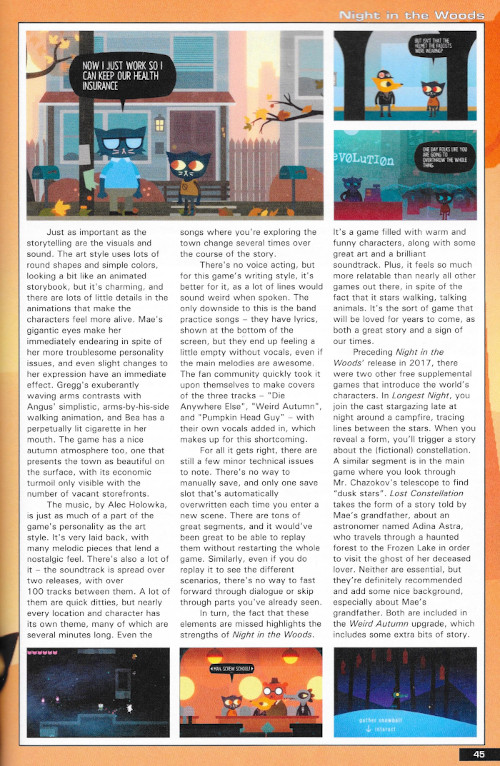
Games are typically described in two pages, and every single page is richly illustrated. (Credit: Hardcode Gaming 101. Fair use.)
On the whole, I found the articles fair and informative, helping me prioritize my backlog and discover some new games. In a couple of cases, the articles went a little too close to spoiler territory for my liking, but that can be hard to avoid when writing about a story-driven game like Lisa or Undertale over multiple pages.
Not a true guide, but still a great introduction
To be truly a guide rather than a collection of articles, the Guide to Retro Indie Games would have benefited from some chapter introductions to the developers or the genres represented here. Nonetheless, if you love indie games and enjoy reading about them in print, I definitely recommend it.
One caveat: the first copy I ordered had severe print quality issues. That kind of thing happens especially with small publications, and Amazon quickly sent a free replacement, so it’s not reflected in the review score. I also bought the second volume, which did not have the issue.
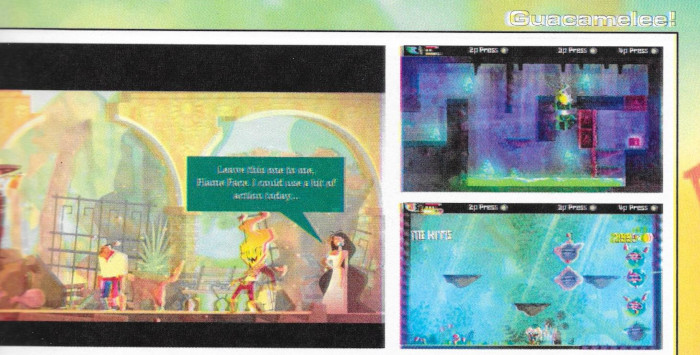
The first printed copy I ordered from Amazon had significant color misalignment issues on every page, rendering the screenshots blurry and almost unreadable. (Credit: Hardcode Gaming 101. Fair use.)
The full list of games in the first volume follows (grouped by publisher):
The Shivah
The Blackwell Series
Gemini Rue
Resonance
Primordia
Technobabylon
Shardlight
Kathy Rain
Thimbleweed Park
Nelly Cootalot
Always Sometimes Monsters
Read Only Memories
Va-11 Halla
Night in the Woods
Pony Island
Mercenary Kings
Flinthook
Odallus
Oniken
Noitu Love
Rogue Legacy
Super Time Force
Volgarr the Viking
Freedom Planet
Westerado
VVVVVV
Shovel Knight
Super Meat Boy
Ultionus
Mystik Belle
Guacamelee!
Axiom Verge
Owlboy
Dust: An Elysian Tail
Hyper Light Drifter
Alwa’s Awakening
Undertale
Lisa
Barkley, Shut Up and Jam: Gaiden
Severed
One Finger Death Punch
Not a Hero
Assault Android Cactus
Hotline Miami
Crimzon Clover
Blue Revolver
Hydorah
l’Abbaye des Morts
Maldita Castilla
The Curse of Issyos
Il locale si presenta molto piccolo, ma ha riservato una sorpresa inaspettata per quanto riguarda il cibo, veramente buonissimo.
Ogni piatto aveva sapori e gusti straordinari - vi consiglio di provare i loro burger, io ho mangiato il Don Chisciotte e ne sono rimasto estasiato.
Tornerò sicuramente.
p.s.: fanno sia colazione, che pranzo, che cena.
Picross is a long-running Nintendo games series that revolves around solving Nonograms, a popular Japanese logic puzzle. The series has been so influential in the popularisation of Nonograms that many people only know them by that name. The puzzle requires filling a grid according to sequences of numbers on the side. Each row and column on the grid has such a number sequence. Following the rules, a cell in the grid is either filled or left empty. Once done, they form a picture.
It’s somewhat similar to another popular Japanese logic puzzle, Sudoku, in that it offers practically infinite puzzle variations and a simple set of rules to complete a puzzle. But contrary to Sudoku, where you have to choose a number ranging from one to nine to fill a cell, for Nonograms, the choice is binary. It is a much simpler type of puzzle in comparison. But in turn, it gains some flexibility. For Sudoku, the grid is fixed in size, whereas Nonograms have arbitrary width and height.
The way I play these two puzzle games totally differs, however. A Sudoku puzzle can be hard to crack, and it is fun spending minutes eliminating possibilities until you’ve found a progression path. With Nonograms, it is the most fun trying to solve them as fast as possible. The significantly easier ruleset allows for this. And with filling a grid cell being a binary choice, it is much easier digitised to a simple button press than Sudoku is. Everything about Picross lends itself to this fast playstyle, and it is a tonne of fun.
With this introduction out of the way, let’s talk about the actual game this review is about.
The actual game
Picross 3D is HAL Laboratory’s attempt at extending this two-dimensional puzzle classic by another dimension. Instead of a grid of cells, you start with a cube that subdivides into many smaller cubes. And instead of constructing a pixel image, you form a voxel sculpture out of the cube.
With this, you can’t really have sequences of numbers on the side. So for this game, it is simplified to one number per line. Although, it’s not quite that simple. Sometimes a number has a modifier, indicated by having the number painted within a square or circle. The number tells you how many consecutive blocks in the line remain part of the final sculpture, and the modifiers tell you how many gaps are allowed in the sequence of blocks.
The game primarily uses the Nintendo DS’s touchscreen for controls. Whereas with other Picross games on the platform, touchscreen controls were optional, here they are mandatory. With the stylus, you rotate the puzzle to look at it from all directions. It works the same with marking cubes to be kept or destroying them.
One nice thing, that differs from how Picross usually works, is that cubes that are marked to be kept cannot be destroyed without unmarking them first. This is great, as the risk of misclicking is high, especially on larger puzzles. It shows that a lot of consideration went into how this game differs from the rest of the series and how its unique qualities necessitate certain things to be different.
Since the puzzle is in 3D, you also have to have the ability to look inside the puzzle, to see things that would be otherwise obscured by other cubes. For this, you can slice the puzzle along the three axes to get a cross-section.
Another unique thing about this game is that it features a rating system. On completion, you can earn up to three stars. One star is always guaranteed. You get another if you solve the puzzle under a certain time threshold. And the final one is earned for not making any mistakes.
The game is broken down into levels that contain a collection of puzzles, and you can advance to the next level after collecting a certain amount of stars.
The other major distinguishing factor of the game is its aesthetics. Picross games are usually quite stylistically plain. This game has a much more distinct visual identity. It features a mascot that is a cube with a face on it that makes celebratory dances as you solve puzzles.
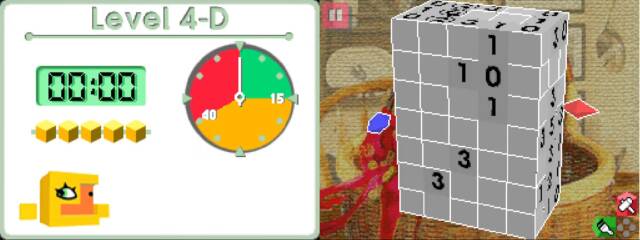
A newly started puzzle with the game’s mascot in the bottom-left. (Credit: HAL Laboratory. Fair use.)
What it feels like
The addition of another dimension to a 2D puzzle game sounds simple enough, but here, it significantly shifts the overall game feel. What was added in terms of complexity was trimmed elsewhere in turn. For example, there might be lines going into three different directions now, but each can only feature one number, instead of multiple, like in classical Picross. The overall logical complexity is similar but achieved through different means. These differences have further side effects on the gameplay beyond just the new controls.
Picross 3D plays very differently from classical Picross, in that the act of solving is much more slow and deliberate. The three-dimensional nature of the puzzles results in you never seeing the whole puzzle at once. Realistically, you can only look at two dimensions at once while solving. In practice, this results in a constant shifting between the three dimensions.
The controls also foster a more deliberate playstyle. Because of the 3D perspective, the cubes heavily vary in size and shape due to their projection onto a 2D screen. This makes misclicking very easy, and thus you have to go slow to avoid mistakes.
The game further incentivises methodical play with its rating system. Making mistakes in this game is easier than ever, and if you make one, a star will be subtracted from your three-star rating.
With all that said, you can probably see that my usual way of playing Picross is on a collision course with this game.
What I don’t like
The required deliberateness during puzzle solving results in a lot of downtime, where you aren’t as much solving a puzzle as you are searching for the next line to advance on. Standard Picross has this too, to an extent. But since you have a full view of the puzzle at all times, downtime due to searching is much smaller. This is especially true once you realise the locality principle to solving standard Picross. When you progress on a line, the corresponding row or column orthogonal to it is also affected, and most of the time, you can directly progress from there. Thus it forms a chain of actions with minimal downtime. As a result, this lends itself to playing the game quickly and is a tonne of fun. And this is the problem with Picross 3D. The puzzles aren’t more challenging, but, due to their 3D nature, are slower to solve. Thus it removes the integral fun component for solving Picross for me and, unfortunately, doesn’t add anything to replace it. The greater emphasis on visual style was enough to keep me playing initially, but after several hours that wore off. After that, the game was just a slog to play.
Furthermore, I have several technical complaints. Once you get into the later stages of the game, the puzzles get big and quite unwieldy. The puzzles take up the entire screen, and looking at multiple dimensions simultaneously, requires you to shift your view around constantly to see what goes over the edges of the screen. The puzzle slicing is even worse. Slicing the puzzle to see only parts of it resizes it on screen accordingly. This produces the problem that when you slice in, the game zooms in, but once you want to slice out, due to the zoom, the point you would have to reach to slice out fully is out of the frame. You have to slice out as far as the screen allows for and redo the motion until you are done. And because of the size of the puzzles, you have to do slicing like this constantly. It’s very annoying.
And again, on larger puzzles, there are severe issues with aliasing, which makes numbers hard to read at certain angles.
Conclusion
Picross 3D seems like a natural and simple extension of standard Picross, but that assumption would be wrong. Bringing Picross to the third dimension significantly alters the gameplay. So much so that it removes why I play Picross in the first place.
The larger puzzles are especially problematic. Not only are the base problems further exacerbated by them, but the game doesn’t even appear to be built to deal with the sheer volume of cubes that make up those puzzles. They make the case that bigger isn’t necessarily better — sometimes it’s just bigger.
4/10
Cardinal Cross is a choice-driven visual novel about a space-traveling scavenger named Lana Brice, who unexpectedly finds herself caught up in a galactic conflict of an astrological nature. The game was written by Roman Alkan and published through her small indie studio LarkyLabs under its ImpQueen brand.
In this universe, predictions derived from the movement and position of celestial objects are as fictionally real as the Force in Stars Wars, or as the fungal excretions of sandworm larvae that make interstellar travel possible in Dune. In most other ways, Cardinal Cross employs familiar sci-fi tropes: cybernetic implants, space rebels, robots and AI, the works.

Lana Brice (left) is a space scavenger with strained family ties. (Credit: LarkyLabs. Fair use.)
Meet the factions
Lana Brice and her friend Wiz, the Mechanic, are part of group of planets known as the Raiders. These folks have gotten the short end of the stick in a conflict with another group known as the Morai System, and they’re generally treated like colonies.
In a black market transaction, Lana and Wiz come in contact with a rogue intelligence agent of the Morai, who is trying to purchase an artifact from them. Most people have cybernetic implants, but this guy is enhanced to the point of almost losing his humanity. He is dangerous, and so are his former employers.
Soon enough, Lana is caught up in a web of conspiracies and plots involving multiple factions. At its center is an astrological supercomputer which the Morai elite use to maintain power and control. Its predictions are not perfect: so-called “howlers”—some humans, objects, planets—elude it completely. (I’m guessing the term is a reference to errors and aberrations rather than monkeys.)
As you might expect from its astrological theme, much of the story revolves around whether our fates are our own to write if the stars seem to already foretell what they are. Thankfully, the story never gets bogged down in sophomoric arguments about free will—it plays out more viscerally through Lana’s choices. That is to say, your choices.
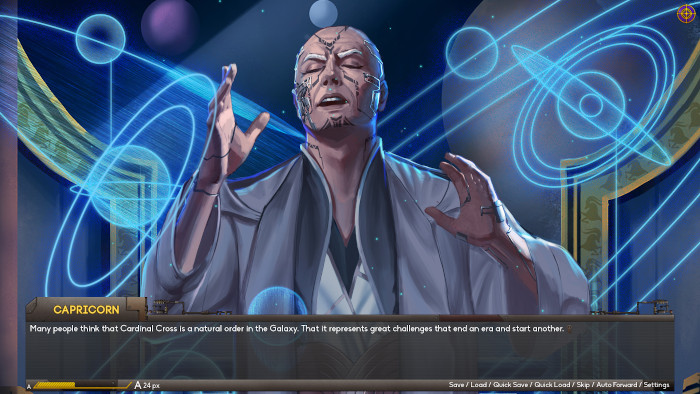
One way or another, Lana’s fate is in the stars. (Credit: LarkyLabs. Fair use.)
Choices and characters
Throughout the story, you get to make more than 100 decisions, typically about things to say, sometimes about things to do. A lot of them have a negligible effect, but you can romance three different characters, influence Lana’s personality, and achieve multiple endings.
The game signals the most important choices with a sound effect, and it makes it clear when you have the option to embark on a romantic adventure. It also displays the effect you have on others (“[name] is annoyed”, “[name] is amused”). These messages are sometimes off-point and immersion-breaking, but you can disable them entirely.
Cardinal Cross is not voice-acted, but it is exceptionally well-illustrated. Not only does it have beautiful character art, it has a ton of it.
There are 50+ side characters, and most of them are visually well-differentiated. It includes 70+ full-screen graphics during special events (“CGs” in visual novel lingo). In case you’re wondering: the graphics for the romantic outcomes are about as tame as what you’d find in a PG-rated movie.
The game has a soundtrack by Jeaniro, which creates suitable ambience without distracting from your reading experience. During the story’s most dramatic moments, the music becomes boisterous or tense, generally fitting the text well.
The story is substantive, but it doesn’t overstay its welcome. I reached an ending which suited my choices well in about 6 hours. After I checked out one other ending with the help of a guide, my total playtime added up to 8 hours.
A good yarn with a few flaws
Roman Alkan’s world-building helps to set the stage effectively, even if the introduction of the in-universe terminology is a bit tedious at first. I had three main issues with the writing:
-
It would have benefited from more editing (there’s some dialogue that’s a bit awkward; there are a few spelling/grammar issues throughout).
-
There are too many characters to keep track of, and the story shifts too quickly between them.
-
Relatedly, the story doesn’t give enough space to some key dramatic moments for us to really grapple with what just happened.
Know that it’s a violent game. Both Lana and the other characters may hurt—and kill—people they come across. Cardinal Cross does not explore its darker themes with the same sensitivity some visual novel writers (like Christine Love) bring to their work; here, transgressions don’t always have the reverberations you would expect.
All in all, though, it’s a good yarn. It riffs on the astrology theme in a way that I’ve personally not encountered in sci-fi (astrology is still annoying, don’t @ me!). It’s a great example of the art form, bringing graphics, music and writing together into a coherent whole. I would enjoy reading about the further adventures of Lana Brice, and will definitely pay attention to ImpQueen’s future works.
